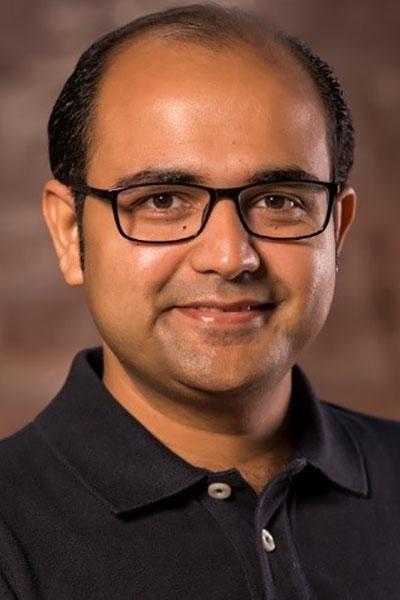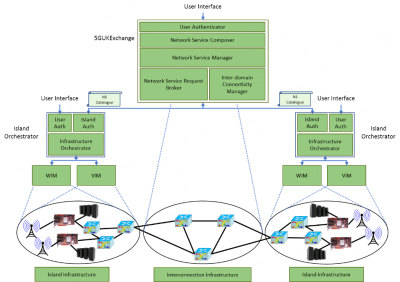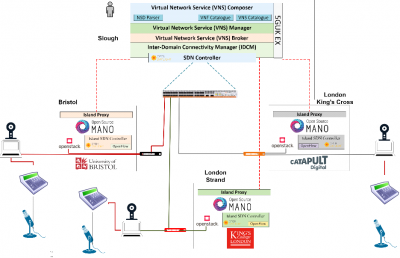Fragkiskos Sardis and Mischa Dohler, King's College London, UK, Navdeep Uniyal and Dimitra Simeonidou, University of Bristol, UK, Dimitrios Gkounis and Dritan Kaleshi, Digital Catapult, UK, Alexander Carôt, Anhalt University of Applied Sciences, Germany
Published: 10 May 2019

CTN Issue: May 2019
A note from the editor:
It is expected that with the advent of 5G and beyond networks, we will continue to enhance the user experience in terms of latency and quality of experience with the aid of advanced mobile side technologies. However, comparatively less focus has been paid so far on the fixed side of the network, i.e., toward the management of physical network computing infrastructure. During the next decade, when 5G and related services will be fully deployed, soon after, we will start noticing the mismatch between the 5G mobile services and outdated fixed networks that would impact the latency, reliability and resilience of the 5G applications. Therefore, in order to avoid such clogging on the fixed side of the networks, we will be looking at new frontiers for next generation of infrastructure management technologies such as network function virtualisation that will close the gap between the fixed and mobile side of the network and guarantee enhanced user experience.
In this article, colleagues from King's College London, University of Bristol and Digital Catapult London first present an overview of the network function virtualisation in 5G networking use cases, especially from the perspective of latency and quality of experience in emerging use cases. Later, the article will present a brief overview of 5GUK testbeds and trials architecture supported by UK’s Department for Digital Culture, Media & Sport followed by proof of the concept of real time audio/video streaming across the distributed sites at partner institutions to demonstrate the scalability, latency and quality of experience capabilities of the architecture. The key idea there being an Openstack and software defined networking (SDN) infrastructure that guarantees the service-oriented transmission with various quality of services requirements at the network level that are coordinated together to produce desired service at the user level.
Enjoy this fascinating real development of 5G networks and as always, your comments are most welcome.
Editor

5GUK Trials: Distributing a Live Orchestra over 5G







Introduction
A little over a decade ago, the wide adoption of virtualisation technology in the datacentre allowed for easier and more efficient management of compute resources. This marked the start of the Cloud Computing era, where large physical infrastructures can be virtualised and scaled elastically according to demand while simplifying the way services are offered to clients by providing templated solutions such as platforms, applications and infrastructures as services. Networking equipment such as firewalls and routers could also be virtualised, creating the concept of Virtual Network Functions (VNF) that could be deployed in the Cloud [1]. Commodity servers could now be used to run virtualised counter-parts of more expensive purpose-built equipment and even consolidate multiple services that would typically run on individual hosts without sacrificing service isolation and security.
5G networking standards make full use of virtualisation capabilities as a means for reducing equipment costs and deployment time and simplifying management of network and services. The standard also calls for light-weight stateless network functions that can easily be scaled at runtime according to traffic demands [2]. However, network operators, unlike traditional Cloud service providers, are not only interested in managing their own infrastructure but also in interfacing with other providers to create cross-domain services for their clients. As such, the need for orchestration in 5G network infrastructures goes beyond intra-domain management and extends to concepts that leverage Software Defined Networking (SDN) technologies for providing Software-Defined Wide Area Network (SD-WAN) [3] connectivity across multiple network providers and for enabling the deployment of VNFs across multiple operator networks, forming a large cross-domain end-to-end slice with guaranteed connectivity characteristics for supporting use cases such as industrial IoT [10, 11], connected vehicles, smart cities [12], cloud gaming and augmented reality.
5G UK Testbeds and Trials Infrastructure
As part of the 5G Testbeds and Trials Programme [4], supported by UK’s Department for Digital Culture, Media & Sport, King’s College London, University of Bristol and University of Surrey have built a 5G network spanning the three universities, interconnected via 10Gbps fibre on an SDN infrastructure and centrally orchestrated via a novel 5G Exchange facility hosted in a datacentre in Slough. Each university island runs its own independent infrastructure built around SDN with Openstack and other vendor-specific Virtual Infrastructure Manager solutions providing hosting capabilities for VNFs. The islands are independently orchestrated by ETSI Open Source MANO [5] and collaboratively orchestrated via the 5GUKExchange [6] in Slough where an orchestrator of orchestrators can create traffic flows to interconnect the islands by creating slices for each individual network service and coordinating with OSM on each island to deploy VNFs within the slices as shown in Figure 1.

The 5GUKExchange uses ETSI based VNF and Network Service (NS) templates to create inter-island service descriptors. These descriptors introduce the concept of inter-island services on top of a network service, thus composing a service tree structure where at the top of the tree is the inter-island service, within it are the component network services for each island, and within each network service are the VNFs that provide the supporting network functions. The network slicing mechanism implements VLANs to isolate tenant networks and QoS parameters (priority, bandwidth) are enforced both by Openstack and the SDN infrastructure. An OSM proxy running on top of OSM on each island leverages the OSM (Northbound Interface) NBI and advertises the network services available on OSM to populate the service inventory at the 5GUKExchange. This modular design enables partners to easily join the testbed by connecting to the Slough facility, deploying OSM and Proxy and registering their island at the 5GUKExchange so their network services can be exposed as inter-island service components.
Distributed Music Performances
One of the prime use cases for the network has been the exploitation of low-latency, guaranteed QoS capabilities of the infrastructure for high-quality live audio/video streaming across sites which in turn enables musicians to perform distributed live concerts. London’s Digital Catapult recently joined the effort by connecting their infrastructure to the 5G Exchange and participating in our first distributed concert across KCL’s Strand campus, Digital Catapult’s offices in London’s King’s Cross and Bristol’s “We The Curious” science centre [9]. Each location streamed live audio and video to partners at a consistent 26ms latency (network latency excluding codec delays was 5ms across all locations) enabling musicians to perform together while audiences at each location would experience the full sound of the orchestra.
At each location, sound and full HD video was transmitted using soundjack [8] and ultragrid [7], respectively. For video, the ultragrid instance at each location streamed the video feed to a reflector VNF deployed at the infrastructure of each site which in turn multiplexed and transmitted the video to the partner sites. This had the benefit of reducing the processing and packet transmission at each end device since the video multiplexing and the increased traffic output was handled by the VNF running on Openstack hosts with 10Gbps network interfaces. Audio was handled on a peer-to-peer basis since the traffic and processing load was much lower compared to video and eliminated the added latency of introducing a reflector for multicasting as shown in Figure 2. Low latency audio could be achieved by immediately sending the generated audio buffers of only 128 samples via UDP to the involved remote peers. Thanks to the stability of our network the measured jitter ranged in the order of microseconds, which allowed us to apply a receiver buffer of only two packets with the corresponding roundtrip latency of only 5.2ms. Since soundjack supports the adjustment of any audio and network parameter, we were able to identify the ideal settings for our network conditions leading to a convenient situation for the involved musicians in terms of latency and quality.

Conclusions
This proof of concept work and successful demonstrations of distributed music performance use cases have set the foundations for exploring connected reality applications that stream real-time virtual reality collaborative environments for artistic and medical applications. King’s College London alongside industry and academic partners are working towards centrally orchestrated, cloud assisted VR applications where people can collaborate at remote locations using thin clients at each end to bring together virtual live performances, virtual meeting rooms and virtual offices with accelerated graphics processing performed in the cloud and content synchronised and delivered over low-latency SD-WAN slicing.
References
- ETSI Network Functions Virtualisation (NFV) Management and Orchestration, online, available at: http://www.etsi.org/deliver/etsi_gs/NFV-MAN/001_099/001/01.01.01_60/gs_NFV-MAN001v010101p.pdf Accessed: 2019-03-20.
- Service-based Architecture in 5G, online, available at: https://www.ngmn.org/fileadmin/ngmn/content/downloads/Technical/2018/180119_NGMN_Service_Based_Architecture_in_5G_v1.0.pdf Accessed:2019-03-20
- SD-WAN: Momentum Builds as Early Adopters Experience Tangible Benefits, online, available at: https://www.cisco.com/c/dam/en/us/solutions/collateral/enterprise-networks/intelligent-wan/idc-tangible-benefits.pdf Accessed: 2019-03-20.
- 5GUK Test Network, online, Available at: https://www.gov.uk/government/case-studies/ HYPERLINK "https://www.gov.uk/government/case-studies/5guk-test-network"5guk-test-network Accessed: 2019-03-20.
- ETSI Open Source MANO (OSM), online, Available at: http://www.etsi.org/technologies-clusters/technologies/nfv/open-source-mano Accessed: 2019-03-20.
- D. Gkounis, N. Uniyal, A. S. Muqaddas, R. Nejabati and D. Simeonidou, "Demonstration of the 5GUK Exchange: A Lightweight Platform for Dynamic End-to-End Orchestration of Softwarized 5G Networks," 2018 European Conference on Optical Communication (ECOC)
- Ultragrid, http://www.ultragrid.cz/specification/ Accessed: 2019-03-20.
- Soundjack, https://www.soundjack.eu/index.php Accessed: 2019-03-20.
- ETSI OSM, Orchestrating the Orchestra [Online]. Available at: https://www.etsi.org/newsroom/news/1565-2019-03-etsi-open-source-mano-orchestrating-the-5g-orchestra-in-a-world-s-first Accessed: 2019-03-20.
- V. Petrov et al., "Achieving End-to-End Reliability of Mission-Critical Traffic in Softwarized 5G Networks," in IEEE Journal on Selected Areas in Communications, vol. 36, no. 3, pp. 485-501, March 2018.
- G. Petropoulos et al., “Software-defined inter-networking: Enabling coordinated QoS control across the internet”, 23rd International Conference on Telecommunications (ICT), pp. 1-5, May, 2016.
- M. Condoluci, F. Sardis, and T. Mahmoodi, “Softwarization and virtualization in 5G networks for smart cities”, International Internet of Things Summit, pp. 179-186, October 2015.
Statements and opinions given in a work published by the IEEE or the IEEE Communications Society are the expressions of the author(s). Responsibility for the content of published articles rests upon the authors(s), not IEEE nor the IEEE Communications Society.


